Medical Aid Levy Calculations
Medical Aid Levy is a percentage or an amount applied to specific Medical Aid schemes to apply a certain mark-up to billing codes based on the Medical Aid plan.
The document will describe levy calculations as they currently are implemented in GXWeb.
For more information regarding Medical Aid Levy and where it can be found, please refer to the user manual: Levy on Medical Aid.
- The contents of this User Manual will consist of the following information:
- Limitations
- Definitions
- Defining the Medical Aid portion of the levy
- Calculation of Medical Aid Levy portions
- Calculation of Medical Aid Levy for consultations-procedures
- Calculation of Medical Aid Levy for stock items
- Take non-preferred provider status into account when dispensing (Shape-4)
- Discount field (Shape-3)
- Actions taken by system
Limitations
- Medical Aid Levy calculations as described in this document are never applied for hospital entities.
- Invoice Levy: Is defined as a portion of an invoice that the Medical Aid is not expected to pay. In some cases, the Practice will expect the patient to pay this amount directly before leaving the Practice after their appointment.
- Value of the invoice levy price: Determined by a combination of amounts that the Practice predefines and amounts that the Medical Aid predefines.
- Medical Aid portion of the levy: Is defined as a portion of a Debtor invoice that the Medical Aid expects the patient to pay. For example, a patient may be expected to pay R10.00 for every medicine item on the invoice.
- Practice portion of the levy: Is defined as a portion of a Debtor invoice that the patient is expected to pay as defined by the Practice. For example, the patient might be expected to pay a balanced billing portion of R200.00 for a first consultation. The Practice portion can also sometimes be auto-generated by the system using billing group rules, or manually captured in GoodX Web.
- The system calculates the Medical Aid portion of the levy after it has processed the last row in the invoice because the levy rules are sometimes dependent on the final price of the invoice and the number of line items in the invoice.
- The calculation of the Medical Aid portion of the levy happens as follows:
- The system “remembers” the Practice portion that has already been allocated to the invoice, as sent in from the front-end by the Practice.
- An amount that should be paid by the patient according to the rules of the Medical Aid is calculated by the system.
- If the amount calculated using the Medical Aid rules is higher than the predefined Practice portion, the difference is added to the levy. The value is defined on a pro-rata basis to the individual line items.
- If the Medical Aid is less than the Practice portion, the levy left at the Practice portion levy, and no further action is taken.
Defining the Medical Aid portion of the Levy
- The Medical Aid Levy calculation rules are imported from Medprax and displayed on the levy screen. The rules can be edited locally.
- Unfortunately, the levy screen is poorly laid out and difficult to understand.
- Here follows an explanation of the layout as the screen is currently defined.
Calculation of Medical Aid levy portions
- Medical Aids provide separate definitions for the calculation of levies for consultation-procedures invoices and stock invoices.
Calculation of Medical Aid levy for consultations-procedures
- Discount is never applied to consultations/procedures.
- The value of calculated using the values typed in the “Procedure Levy” Box
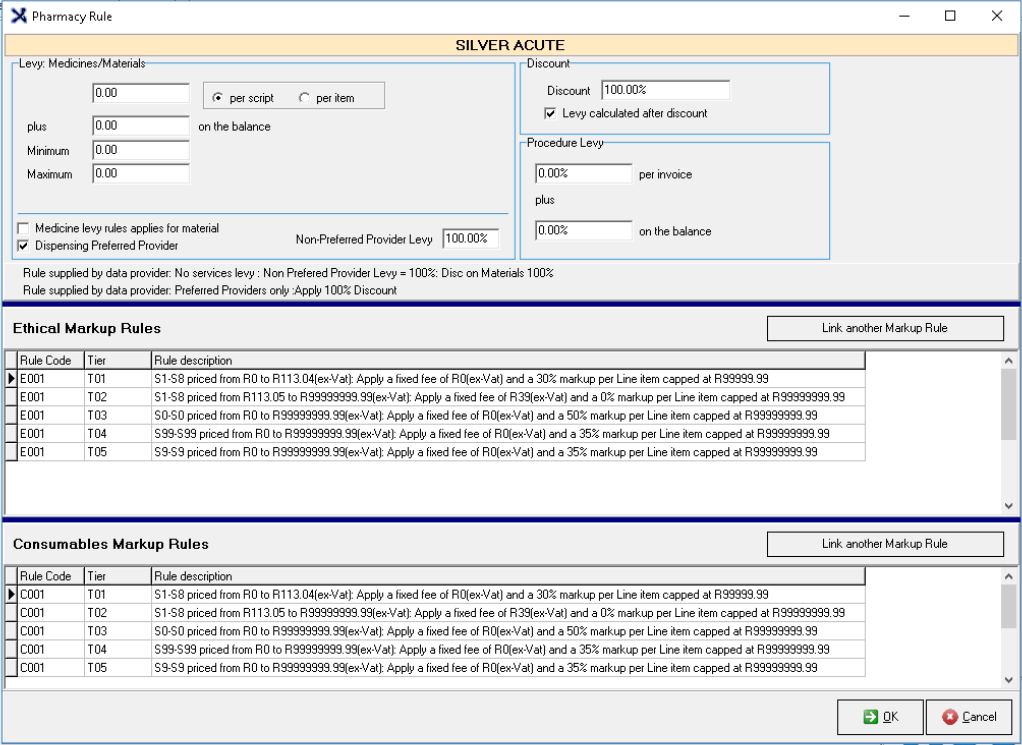
- When a % (percentage sign) is displayed in the edit box, the value will be calculated as a percentage of the value of the Invoice. When a % (percentage) sign is not displayed, the value in the box is interpreted as a currency value (Rand value in South Africa).
Examples:
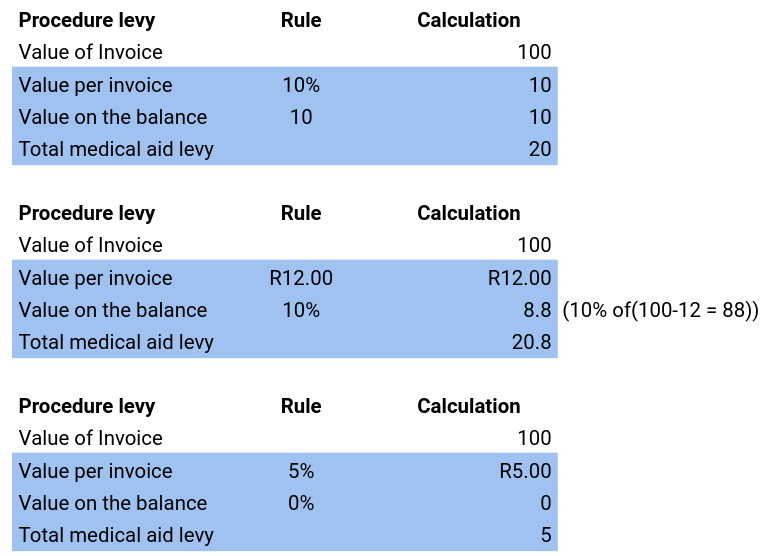
Calculation of Medical Aid Levy for stock items
- This calculation is complex. The explanation below refers to the red numbers in the following screenshot.
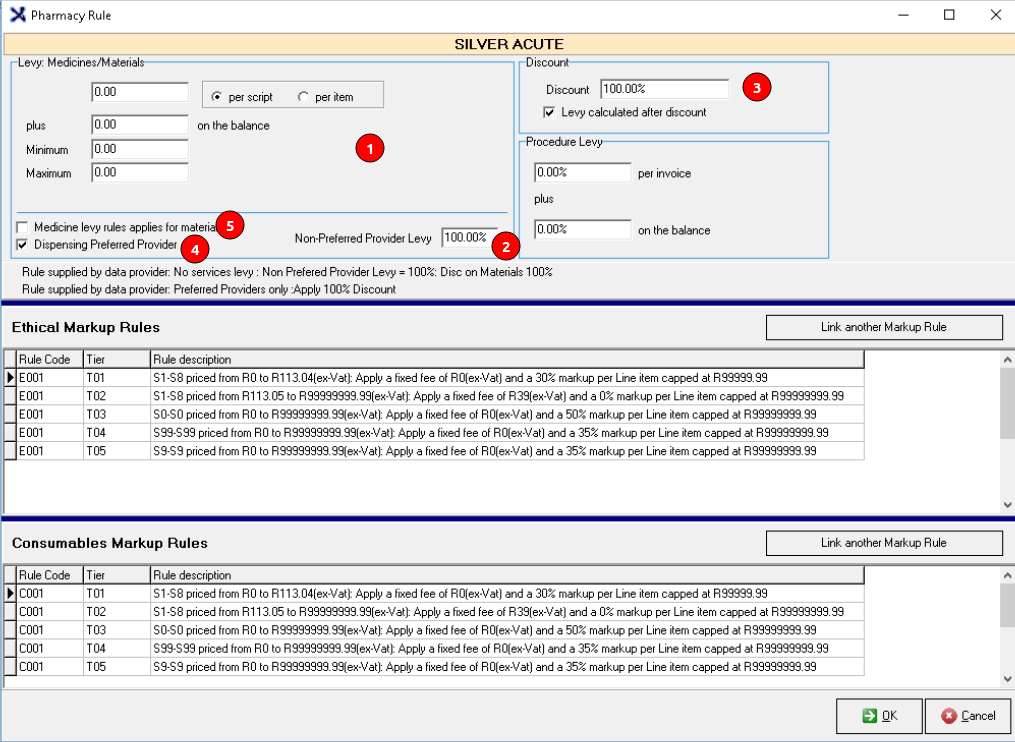
Take non-preferred provider status into account when dispensing (Shape-4)
- Some medical aids classify providers as preferred or non-preferred. Patients generally pay a lower levy if they elect to visit a preferred provider, than when they elect to visit a non-preferred provider.
- When a patient visits a preferred provider, they sometimes qualify for a discount on the stock or medicines as defined in Shape-3. The Shape-3 rule originates out of the concept of “fee for service” billing. The idea is that for preferred providers the Medical Aid pays for the service and that any medicine and/or stock used or dispensed during the service is included in the price of the consultation. Currently, the system will only apply this discount when the discount percentage is set to 100%. Any other value is ignored. The discount feature seems to have been discontinued by medical aids in recent years but is retained for backward compatibility.
Discount field (Shape-3)
- As described above in the Shape-4 notes 100% discount may be applied when the provider status is taken into account during the levy calculation.
- The discount value is also supposed to be taken into account for the Shape-1 rule, regardless of whether the discount is set to 100% or not. In this case, the discount is applied before or after the standard levy calculation as defined in the rule. This has not been implemented in the GoodXWeb code.
Actions taken by system
- The system checks whether the Practice has been flagged as a preferred provider for the Medical Aid on the Medical Aid screen. The current setting is reflected as indicated by shape
6. It is set up by clicking the “preferred provider” checkbox on the Medical Aid option screen. All providers are classified as
“non-preferred providers” by default.

- The system checks whether the “Take non-preferred provider status into account when dispensing” checkbox has been checked. (Shape-4) If the checkbox has been checked the system applies the provider/non-provider rules as defined in Shape-2 and Shape-3. This is referred to as the PPCASE further in this document.
- NOT a PPCase: the system applies the rule as defined in the “Levy: Medicines / Materials” box (Shape-1 ) regardless of whether the Practice is flagged as a preferred provider or not.
- PPCASE – preferred provider: If the Practice is defined as preferred provider the system checks whether the Discount defined in Shape-3 is set to 100%. It has been set to 100%, the price of all stock and/or medicine will be not be charged for at all. If the discount is not set to 100% Shape-1 rule is applied.
- PPCASE – NON preferred provider: apply Shape-2
rule.
- The system checks the “Medicine levy rules applied for material” rule (Shape-5) to determine whether to apply the levy for materials (0201 items). By implication, the rule is
always applied for medicines (GMED).
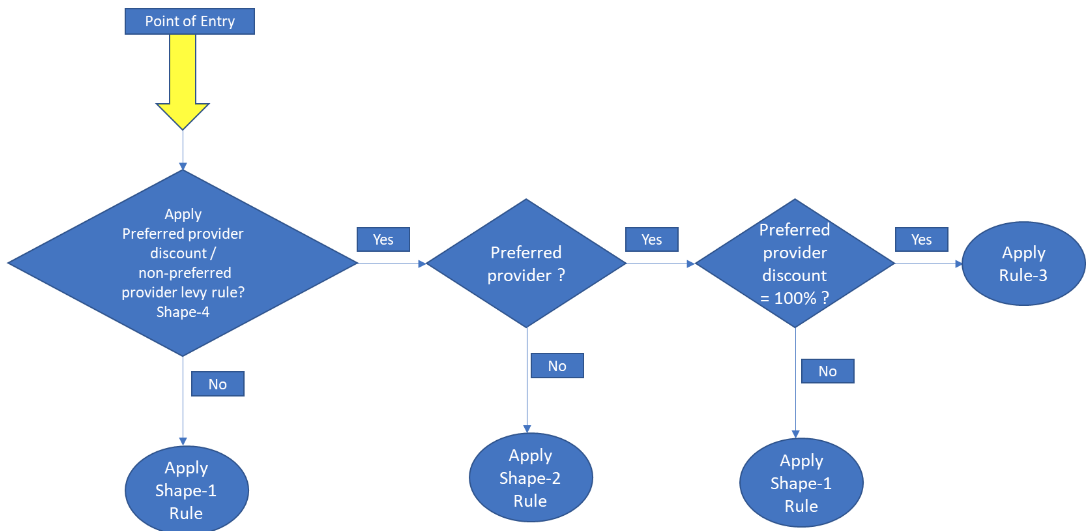
Examples:
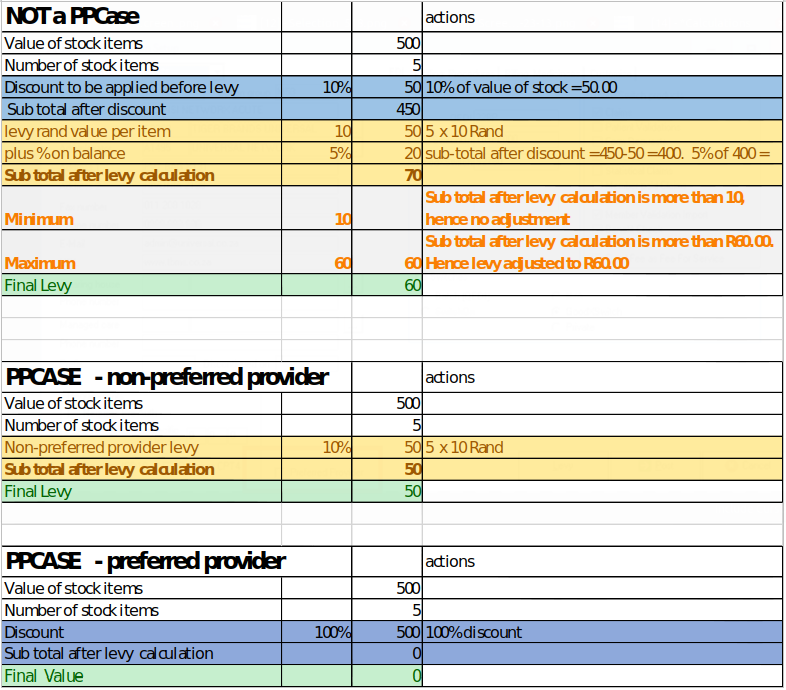
Last modified: Friday, 21 January 2022, 9:49 AM